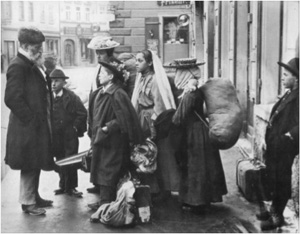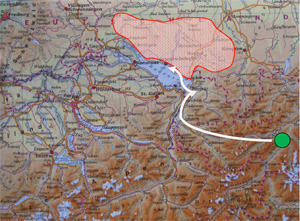4. Where they had to go to (Part 2)
 | Collection point in Landeck for the trip into Swabia |
 | The labour catchment area of the Swabian children |
 Click image to enlarge
Click image to enlarge
Questions
Description and Analysis
The time away from home:
A contemporary witness, Adolf Thurnes, in 1973 remembered his time as a Swabian child as follows:
“At the child labour market in Friedrichshafen, the children stood positioned between ropes; the farmer picked up whichever child he liked the look of, lifted him up over the ropes and took him home with him.”
The children worked as herders, they worked in the fields or in the homes.
On St Martin’s Day (11th November) they started their journey back to the Tyrol. Provided that they had found work with good employers, they had a few Guilders in salary with them and were clad in new clothes.
From 1915 attempts were made by the state to put a stop to this form of labour migration. To compensate for this “loss of earnings” the authorities promoted home industries. Only the young Republic of Austria succeeded in abolishing the forced migration of the Swabian children. The last documented migration of Swabian children was in 1926.
Answers to the Questions
- It is a photo from the year 1892.
- Six children are pictured: three girls and three boys.
- They are wrapped up warm, and are wearing either jackets or overcoats. All have a hat on. Their shoes look very worn.
- They are carrying rucksacks, simple suitcases or bags, but also plastic bags on their backs.
- They are in a town square.
- The picture was certainly taken at a cooler time of the year – in spring or late autumn – ready for the trek back to the Tyrol.
- “Do we have to wait much longer? Can’t we set off soon?.. ”





Presentation
As soon as a farm child became seven years old, it was felt that he was able to earn his living himself abroad. Every spring whole groups of children accompanied by adult helpers walked north over wild mountain trails to the area around Lake Constance. They were examined almost like animals by the farmers on the herding children markets and hoped to find work for the summer. In autumn when the farming year came to an end, the children would set off again on their long march home.